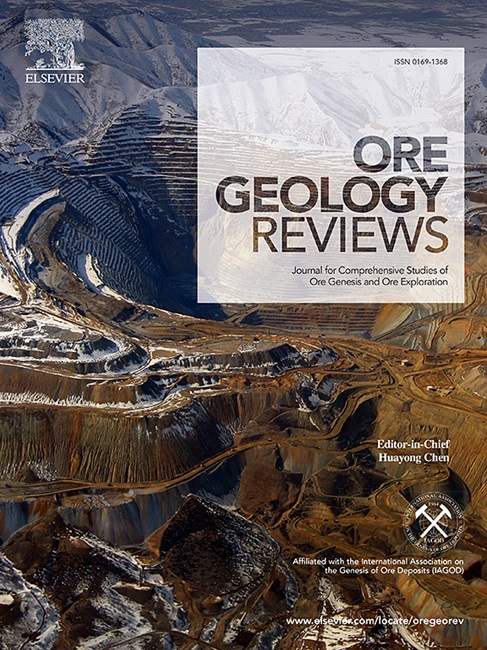Quartz textures and compositions of the Axi epithermal gold deposit, Xinjiang, NW China: Implications for coprecipitation mechanism of silica and metals
IF 3.6
2区 地球科学
Q1 GEOLOGY
引用次数: 0
Abstract
The textural characteristics of quartz are crucial for understanding the evolution of ore-forming fluids and the mechanisms of mineral precipitation, as they can record hydrothermal physicochemical conditions. The Axi deposit is one of the largest low-sulfidation epithermal gold deposits in the Western Tianshan, Xinjiang, where four ore-forming stages with various quartz textures developed, but the coprecipitation mechanism between quartz and metals remains enigmatic. In this contribution, scanning electron microscope cathodoluminescence (SEM-CL) and laser ablation inductively coupled plasma mass spectrometry (LA-ICP-MS) were conducted to study the formation process of these textures and their composition variations. Four generations of quartz were identified: (1) spheroidal, colloform SiO2 (Qz1s), and crustiform quartz (Qz1c) exhibiting oscillatory CL intensity accompanied by bladed ankerite and electrum; (2) cryptocrystalline/mosaic quartz (Qz2) with dark CL; (3) microcrystalline quartz (Qz3) coprecipitated with abundant ankerites and sulfides displaying relatively bright CL; (4) euhedral comb/zonal quartz (Qz4). Integrated studies suggests that the development of these textures is a record of fluctuations in the fluid boiling degree. The coprecipitation of metals and colloidal silica within stages I and III indicates that metal nanoparticles could be mechanically transported with the protection of colloidal silica in hydrothermal solution. Boiling-induced turbulence could enhance the collision and aggregation of colloidal particles, which might be the principal mechanism leading to mineral precipitation. Simultaneously, quartz composition reveals that ore precipitation is always accompanied by a considerable reduction in Al content, which could be ascribed to the fluid degassing-induced escape of acid volatiles (e.g., CO2, H2S) and the precipitation of carbonate minerals, thereby leading to an increase in fluid pH. The Al content in the four generations of quartz exhibited a pattern of initial increase followed by a subsequent decrease, represents a multi-stage injection pattern of hydrothermal fluids. In consequence, the variation of Al content quartz might be the fingerprint parameter contributing to the ore precipitation process in the epithermal deposit.

新疆阿西浅成热液金矿床石英结构与组成:石英与金属共沉淀机制的启示
石英的结构特征可以记录热液物理化学条件,对了解成矿流体演化和矿物沉淀机制具有重要意义。阿西金矿床是新疆西天山地区规模最大的低硫化浅成热液型金矿床之一,发育4个不同石英结构的成矿期次,但石英与金属的共沉淀机制尚不清楚。利用扫描电镜阴极发光(SEM-CL)和激光烧蚀电感耦合等离子体质谱(LA-ICP-MS)研究了这些织构的形成过程及其组成变化。鉴定出4代石英:(1)球形、胶状SiO2 (Qz1s)和壳状石英(Qz1c),表现出CL强度振荡,并伴有刃状铁白云石和银质;(2)暗色CL的隐晶/镶嵌石英(Qz2);(3)微晶石英(Qz3)与丰富的铁白云石和硫化物共沉淀,CL较亮;(4)自形梳状/带状石英(Qz4)。综合研究表明,这些结构的发展是流体沸腾度波动的记录。第一阶段和第三阶段金属和二氧化硅胶体的共沉淀表明,金属纳米颗粒在水热溶液中可以在二氧化硅胶体的保护下进行机械输送。沸腾引起的湍流可以增强胶体颗粒的碰撞和聚集,这可能是导致矿物沉淀的主要机制。同时,石英组成表明,矿石析出总是伴随着Al含量的大幅度降低,这可能是由于流体脱气导致酸性挥发物(如CO2、H2S)的逸出和碳酸盐矿物的沉淀,从而导致流体ph值的增加。四代石英中Al含量呈现先增加后减少的规律。代表了热液流体的多级注入模式。因此,铝含量石英的变化可能是影响浅成低温热液矿床中矿石沉淀过程的指纹参数。
本文章由计算机程序翻译,如有差异,请以英文原文为准。
求助全文
约1分钟内获得全文
求助全文
来源期刊

Ore Geology Reviews
地学-地质学
CiteScore
6.50
自引率
27.30%
发文量
546
审稿时长
22.9 weeks
期刊介绍:
Ore Geology Reviews aims to familiarize all earth scientists with recent advances in a number of interconnected disciplines related to the study of, and search for, ore deposits. The reviews range from brief to longer contributions, but the journal preferentially publishes manuscripts that fill the niche between the commonly shorter journal articles and the comprehensive book coverages, and thus has a special appeal to many authors and readers.
 求助内容:
求助内容: 应助结果提醒方式:
应助结果提醒方式:


